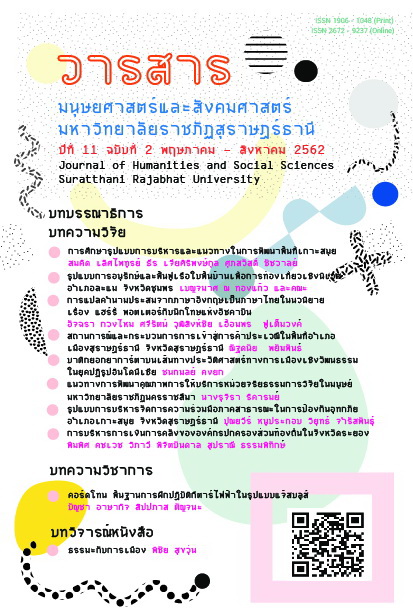Yogyakarta’s Batik on the History Path of Cultural Politics in the Indonesian Reformasi Period
Main Article Content
Abstract
This research article aims to study the history path of cultural politics of Yogyakarta batik during the Indonesian Reformasi period, which results from UNESCO recognition of Indonesian batik as a world heritage in 2009. This achievement is like creating an official identity for the Indonesian nation. However, this operation is full of culturally political movements with the conflict about the ownership of batik culture between Indonesia and Malaysia. The reason for choosing the batik of Yogyakarta city in this study is its being regarded as "Classical batik or traditional batik" of Indonesia. The batik of Yogyakarta city, in turn, becomes the representative image of the Indonesian batik. In addition, Yogyakarta city is important in terms of Indonesian political and cultural history. From the perspective of political history, Yogyakarta was an important city in the Indonesian state which was once the capital of the Indonesian capital during the independence claim. This city has been designated as the Yogyakarta Special Administrative Region until the present. As for the perspective of culture, the city of Yogyakarta is a city that still preserves traditional Javanese culture, one of which is the culture known as “batik.” From the perspective of Javanese culture, Batik of Yogyakarta city is more than just a valued way of dressing. It also reflects Javanese society as well as the whole of Indonesian society. In addition, the Javanese, who are the main population of the country, have enhanced Javanese prominence through arts and culture. Javaneseness transmitted through the batik of
Yogyakarta city was therefore part of Indonesian national identity. The implications show that politics and culture cannot be separated from each other.
Article Details

This work is licensed under a Creative Commons Attribution-NonCommercial-NoDerivatives 4.0 International License.
All published manuscripts have been verified by peer-peer professors in the fields of humanities and social sciences. Reprinting of the article must be authorized by the editorial staff.
References
Anderson, B. (1990). Language and Power: exploring political cultures inIndonesia. New York: Cornell Paperbacks.
Chaiwat Larnchim. (2016). Cultural Politics of Javanese Society in the 19th Century: Reflections on the Concept of the State of the Drama. Journal of Southeast Asia, 5(1), 2-36 . (In Thai)
Department of Trade Negotiations in Ministry of Commerce. (2014).Awareness of investment in ASEAN: Republic of Indonesia.
(n.p., n.d.). (In Thai)
Economic and Social Commission for ASIA and the Pacific. (2014). Asia-Pacific trade and investment report 2014 : Recent Trends and Developments. New York: United Nations publication.
Elliott, I.M. (1984). Batik Fabled Cloth of Java. New York: Periplus Editions.
Fraser-Lu, S. (1986). “Indonesian Batik” Process, Patterns and Places. New York: Oxford University Press.
Hall, D.G.E. (1979). A History South-East Asia. Book 2. Translated byThanpuying Waroon Yupanitwong Na Ayutthaya et al. Bangkok: Foundation for Textbooks, Social Sciences and Humanities. (In Thai)
Hall, S. (1992). Cultural Studies and Its Theoretical Legacies. In Cultural Studies. edited by Lawrence Grossberg, Cary Nelson and Paula
Treichler. (pp. 277-294). London: Routledge.
Herzfeld, M. (2005). Cultural Intimacy: Social Politics in the Nation-State.New York: Routledge.
Himpunan Pencinta Kain Batik & Tenun. (1990). Sekaring Jagad Ngayogyakarta Hadiningrat. Jakarta: Wastraprema. (In Indonesia)
Keller, I. (2002). Batik: The art and craft. Clarendon: Tuttle Publishing.
Natapong Chitniratna. (2007). The community. (2nded). Songkhla: Thaksin University. (In Thai)
Panuwat Panduprasert. (2013). History of Decentralization in Indonesia. The 14th National Conference on Political Science and Public
Administration (2013). Ubon Ratchathani University. (In Thai)
Princess Maha Chakri Sirindhorn Anthropology Centre. (2009). Batik is anational treasure or heritage of mankind?. [Online]. Retrieved from http://www.sac.or.th/exhibition/aseantimeline. [2017, October 30]. (In Thai)
Proyek Pengembangan Industri Kecil Dan Menengah. (1996). Katalog BatikKhas Yogyakarta. Yogyakarta: Kantor Wiyalah Departmen Perindutrian. (In Indonesia)
Reid, A. (2011). To Nation by Revolution: Indonesia in the twentieth century.Singapore: NUS press.
Sandholz, S. (2017). Urban Centres in Asia and Latin America: Heritage andIdentities in Changing Urban Landscapes. Switzerland: Springer International Publishing.
Setiawan, D. (2015). Jogja Fashion Week Carnival Costume in The Context of Locality. Journal of Arts Research & Education, 15(2), 126-131.
Soedewi, S. (2011). Technic and Decorative Varieties of Yogya & Solo’s Batik. Yogyakarta: Naturatama. (In Indonesia)
Soewarsono, M.A. (2011). Nationalism and Cultural Resilience in Indonesia: A Challenge. Jakarta: Lipi Press. (In Indonesia)
Sutardi, T. (2007). Anthropology: Revealing Cultural Diversity. Bandung: PTSetia Purna Inves. (In Indonesia)
Suwattana Maneecharuen. (2015). Constitution of the Republic of Indonesia on 1945 with the concept of Nationality. Veridian E-Journal, Thai Version, Silpakorn University, Humanities-Social Science and Arts Program, 8(2), 1964-1976. (In Thai)
Tirta, I. (1996). Batik: A Play of Light and Shades. Jakarta: PT Gaya FavoritPress. (In Indonesia)
Vickers, A. (2005). A History of Modern Indonesia. Cambridge: CambridgeUniversity Press.

